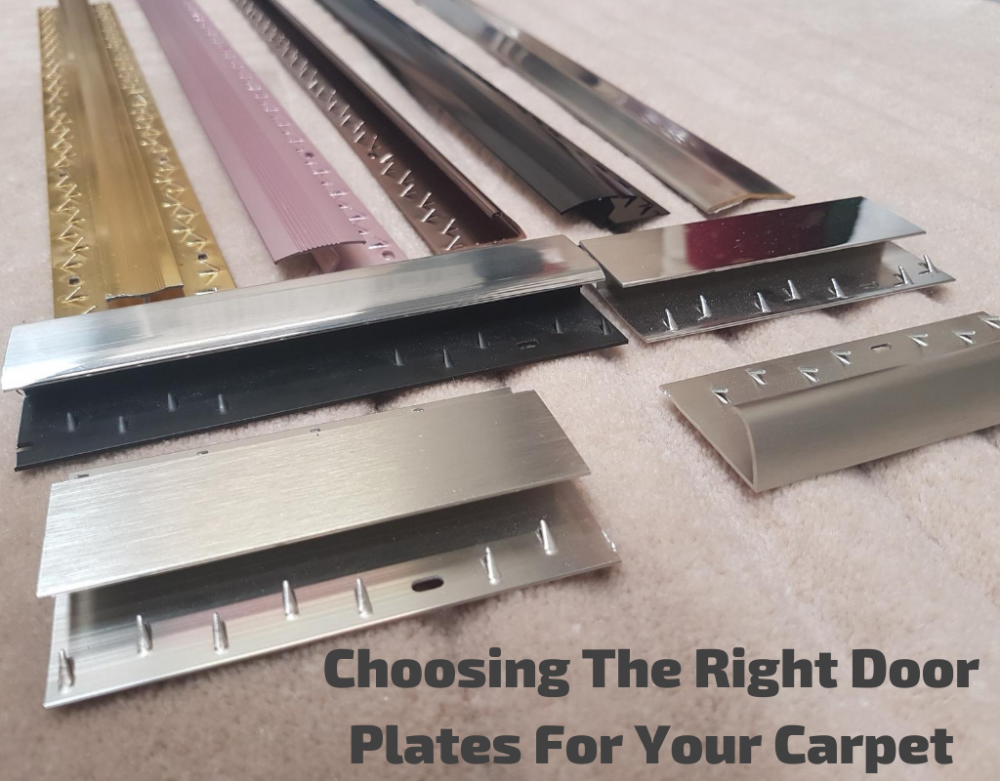You’ve chosen your carpet, decided on which underlay to have, but now you have to choose your door plate. Surely that’s the easy bit and there can’t be much to choose from, after all, a door plate is just a strip of metal. So how much choice could there be?
However, choosing the right door plate for your carpet can make quite a bit of difference to the look and feel of the finished room. Door plates can come in a multitude of colours and designs, from traditional to modern, from black, white and a rainbow of colours. So the design and colour you choose can really make a significant difference to how your room looks and feels.
Why do we need Door Plates?
Before we guide you through how to choose a door plate it’s perhaps important to first understand what we need them for and what function they perform.
A door plate acts as a join between different rooms or even different floorings. Floorings such as carpets are fitted per room, so if you have a carpet in a lounge and another in the hall, both rooms will be fitted with separate carpets. If the carpet is the same quality, style and colour then it would be possible to join them, but the join would be noticeable.
Additionally, the join could start to fray as a result of footfall. Instead, it is safer and creates a better appearance to fit a door plate. What this means is that your carpet is tucked under the plate, which provides a straight edge and also stops any fraying. If going from one type of carpet to another or from one type of flooring to another (such as carpet to wood), you would definitely need a door plate.
Door plates come in different “profiles” to accommodate the different floorings being used. For example, a carpet to carpet door plate is known as a “Dual”, a carpet to hard floor (where both floors are at the same level) is known as a “Z”. Where you have two floorings meeting at different levels, a “Single” can be used. Other types of plates include “Covers” and “Screw-downs”. There are also more specialised plates for more un-even surfaces, such as “Ramps” “Lips” and “Edges”.
With so many, which do a choose?
Regarding the type, be it “Dual”, “Single”, “Z” or whatever, your flooring experts will advise and guide you through which type is required and all you need to do is decide on the colour and the design.
Firstly, the colour. Are you replacing all door plates in the given area or just the one? If it is just the one, then you should try to match any other remaining plate. If you are replacing all then it is often best to match your door furniture. For example, if the handles on your doors are chrome or brushed chrome, then it is best to match this with a silver, chrome or aluminium coloured plate.
Basically, try to make all metal work on or around the door match. Additionally, think about the character of your home. Is it old and traditional or modern and contemporary? There are different designs and colours of door plates to suit either, from antique brass through to white, black and even more colourful types.
Next, think about the quality. All door plates are not the same and as with most things in life, you pay for what you get. A standard door plate will cost a few pounds and will look OK but can scratch and dent easily. More expensive door plates are more robust and have a better finish to them. They’ll also maintain their look and finish for much longer.
At Mountain & Cowell classic and contemporary flooring we will be able to guide you through which is the ideal door plate for the room you are having fitted. It’s our job to know, because we care!
Our Home Improve flooring panel of flooring experts can be contacted at…







buy generic lasuna over the counter – buy cheap generic lasuna how to get himcolin without a prescription
buy generic besifloxacin – purchase sildamax online purchase sildamax sale
cheap gabapentin without prescription – ibuprofen drug buy sulfasalazine pill
buy benemid 500mg pills – probenecid cheap carbamazepine 400mg tablet
purchase celebrex pill – flavoxate drug order indomethacin 75mg online
voltaren online – aspirin 75mg canada where to buy aspirin without a prescription
mestinon ca – order sumatriptan 25mg generic buy imuran 25mg online cheap
purchase diclofenac online cheap – cheap nimotop sale buy nimotop tablets
buy baclofen without prescription – piroxicam 20mg canada feldene order online
mobic 7.5mg cheap – purchase meloxicam pill order generic toradol 10mg
periactin 4 mg ca – cyproheptadine medication generic tizanidine 2mg
buy artane tablets – buy generic artane how to order emulgel
cefdinir sale – buy clindamycin cheap
buy prednisone 10mg pills – buy prednisolone generic elimite over the counter
purchase permethrin for sale – where to buy benzac without a prescription buy generic retin online
betnovate 20 gm cheap – buy benoquin sale monobenzone online
purchase metronidazole pills – cenforce order online brand cenforce
brand augmentin – synthroid 150mcg oral order levothroid pills
generic cleocin 150mg – buy cheap indocin indocin tablet
order cozaar 50mg – buy cozaar keflex 250mg tablet